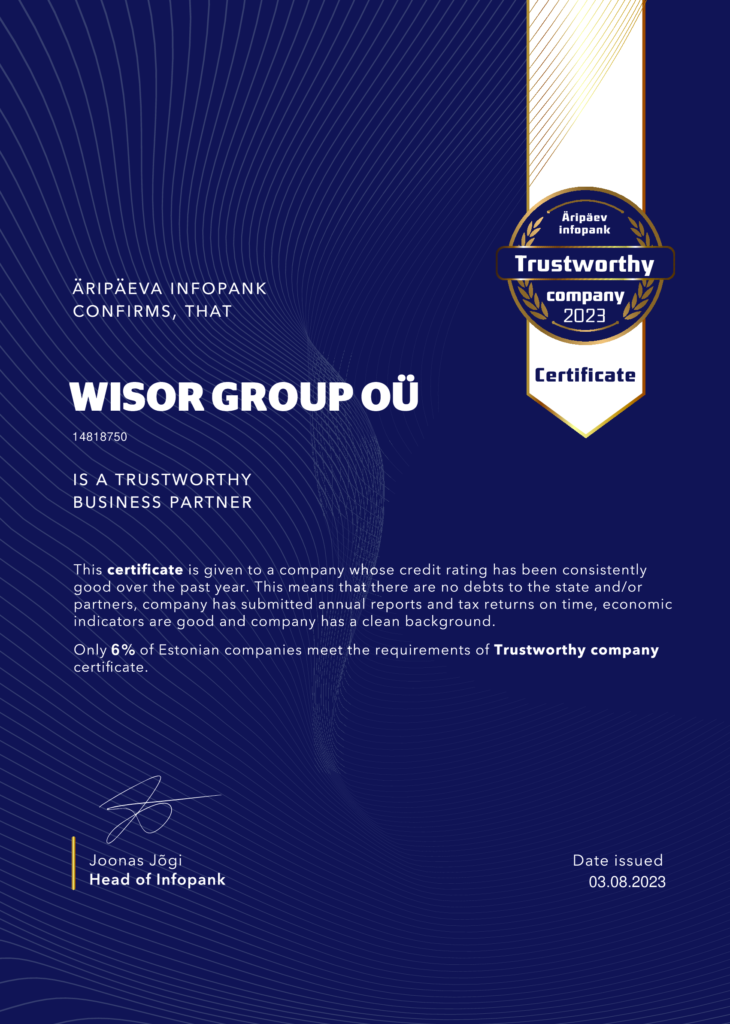The world of cryptocurrency has experienced significant growth in recent years, and with it, the need for comprehensive regulatory frameworks has become more pressing. One of the most important pieces of legislation for crypto businesses in Europe is the Markets in Crypto-Assets Regulation (MiCA).
For companies registered in Estonia, which is considered one of the most crypto-friendly nations in the EU, MiCA introduces a new regulatory landscape. In this post, we’ll dive into the latest MiCA updates and what they mean for crypto businesses in Estonia.
Read also about crypto company registration in Estonia.
What is MiCA?
MiCA (Markets in Crypto-Assets Regulation) is a regulatory framework introduced by the European Union, aimed at providing legal clarity and consumer protection for the rapidly growing crypto-asset sector. The legislation covers a wide array of crypto-assets, including cryptocurrencies like Bitcoin and Ethereum, stablecoins, and utility tokens. MiCA also applies to service providers, such as crypto exchanges, wallet providers, and other intermediaries.
The primary goal of MiCA is to create a harmonized regulatory framework across all EU member states. This would enhance legal certainty for crypto businesses, protect investors, and ensure that financial stability is maintained.
Key Features of MiCA
1. Comprehensive Coverage: MiCA provides clear definitions for various crypto-assets and their classifications. This removes the ambiguity that often surrounds digital assets, allowing businesses to understand what regulatory requirements apply to them.
2. Licensing Requirements: Crypto service providers, including exchanges, custodians, and token issuers, will need to obtain specific licenses to operate across the EU. Once a company is licensed in one member state, they can legally operate in any EU country—a major advantage of this unified framework.
3. Consumer Protection: The regulation places a strong emphasis on consumer protection, mandating that crypto businesses provide transparent information about their services, risks, and pricing.
4. Stablecoins Under Scrutiny: MiCA introduces stricter rules for issuers of stablecoins, particularly large-scale stablecoins that could have a significant impact on the economy. Issuers must maintain reserves and meet stringent transparency standards.
5. Anti-Money Laundering (AML) Compliance: MiCA enhances AML compliance requirements forcrypto companies, in line with the EU’s existing regulations. This includes customer due diligence, reporting obligations, and risk assessments.
What MiCA Means for Crypto Businesses in Estonia?
Estonia has been a popular destination for crypto-related businesses, thanks to its favorable business environment, advanced digital infrastructure, and forward- thinking regulatory framework. However, the introduction of MiCA brings new regulatory challenges and opportunities for Estonian crypto companies.
1. Increased Licensing Requirements: While Estonia has already been stringent in its licensing for crypto service providers, MiCA introduces a standardized licensing regime across Europe. Estonian businesses that are currently licensed may need to apply for additional licenses or ensure they meet MiCA’s requirements. The good news is that once licensed, these businesses can operate freely throughout the EU.
2. Higher Compliance Standards: Estonia’s Financial Intelligence Unit (FIU) has historically been proactive in regulating the crypto space, focusing on AML and KYC (Know Your Customer) standards. Under MiCA, businesses will face even stricter compliance obligations. This means companies will need to invest more in regulatory technology (RegTech) and legal resources to stay compliant.
3. Opportunities for Expansion: MiCA offers crypto companies the chance to expand their operations across Europe without facing multiple layers of regulations in different countries. Once a company is MiCA-compliant in Estonia, it can provide services in any EU member state without needing additional local licenses.
4. Consumer Trust: MiCA’s focus on consumer protection will likely increase trust in crypto businesses operating in Estonia. By ensuring transparency, reducing risks, and offering greater legal certainty, businesses can attract more customers who may have been hesitant due to the perceived risks of cryptocurrency.
5. Stablecoin Issuance: For companies in Estonia that are working on stablecoins, MiCA will introduce significant new requirements. These businesses will need to ensure they have sufficient reserves and meet disclosure requirements, particularly if their stablecoins are widely used.
MiCA and Crypto Businesses in Estonia: Preparing for the Future
The MiCA regulation represents a significant shift in how crypto businesses operate across Europe. For Estonian companies, it offers both challenges and opportunities. Estonian businesses will need to review their operations to ensure compliance with the new framework, but at the same time, they will be better positioned to expand across the EU under a single regulatory regime.
Estonia’s proactive stance on digital innovation means that the country is well-placed to adapt to MiCA and continue to be a hub for crypto-asset businesses. However, it’s essential for businesses in Estonia to stay informed about the latest developments and take early steps toward compliance. This includes engaging legal counsel, investing in compliance technologies, and understanding the specific requirements that MiCA places on their operations.
Need Help with Your Crypto Business in Estonia?
MiCA marks a new era for cryptocurrency regulation in Europe, and Estonia’s crypto businesses are at the forefront of this transformation. The regulation provides clarity, protects consumers, and facilitates cross-border expansion—all of which are essential for the continued growth of the crypto sector.
At Wisor Group, we specialize in helping crypto businesses in Estonia navigate the complex regulatory landscape. Whether you need assistance with company registration, licensing, or compliance with MiCA regulations, our team of experts is here to guide you every step of the way. Contact us to learn more about how we can help your crypto business thrive in the new regulatory environment.



